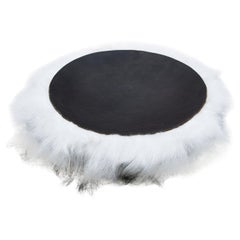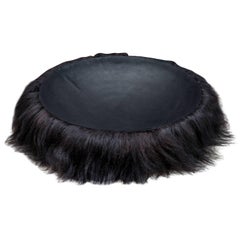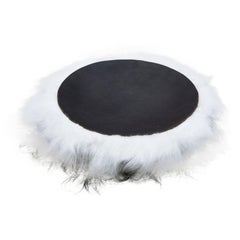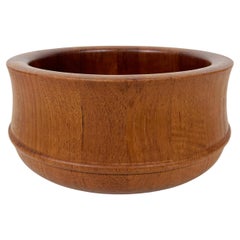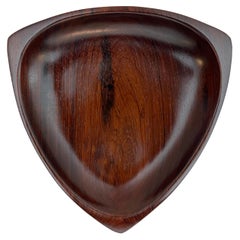Sheepskin Decorative Bowls
6
to
2
6
6
6
6
Height
to
Width
to
1,315
3,367
2,935
2,504
1,455
6
6
6
Material: Sheepskin
Hairy Wild Man from Botany Bay Bowl Black by Trent Jansen
By Trent Jansen
Located in Beverly Hills, CA
Broached Monsters by Trent Jansen
The vast majority of mainstream Australian mythology commonly used as a
foundation for Australian identity is culturally exclusive. Both Indigenou...
Category
21st Century and Contemporary Australian Sheepskin Decorative Bowls
Materials
Aluminum
Hairy Wild Man from Botany Bay Bowl Grey by Trent Jansen
By Trent Jansen
Located in Beverly Hills, CA
Broached monsters by Trent Jansen
The vast majority of mainstream Australian mythology commonly used as a
foundation for Australian identity is culturally exclusive. Both Indigenous myths, including post-colonial myths and precolonial dreaming stories, and non-indigenous Australian myths, including the bush legend, ANZAC tradition and convict legend, focus on the historical role that the race of authorship has played in building the nation. However, a contemporary understanding of Australian history...
Category
21st Century and Contemporary Australian Sheepskin Decorative Bowls
Materials
Aluminum
Hairy Wild Man from Botany Bay Bowl White by Trent Jansen
By Trent Jansen
Located in Beverly Hills, CA
Broached Monsters by Trent Jansen
The vast majority of mainstream Australian mythology commonly used as a
foundation for Australian identity is culturally exclusive. Both Indigenous myths, including post-colonial myths and precolonial dreaming stories, and non-indigenous Australian myths, including the bush legend, ANZAC tradition and convict legend, focus on the historical role that the race of authorship has played in building the nation. However, a contemporary understanding of Australian history...
Category
21st Century and Contemporary Australian Sheepskin Decorative Bowls
Materials
Aluminum
Hairy Wild Man from Botany Bay Bowl Grey by Trent Jansen
By Trent Jansen
Located in Beverly Hills, CA
Broached monsters by Trent Jansen
The vast majority of mainstream Australian mythology commonly used as a
foundation for Australian identity is culturally exclusive. Both Indigenous myths, including post-colonial myths and precolonial dreaming stories, and non-indigenous Australian myths, including the bush legend, ANZAC tradition and convict legend, focus on the historical role that the race of authorship has played in building the nation. However, a contemporary understanding of Australian history acknowledges the contribution of both Indigenous and non-indigenous Australians in forging the nation, and the national identity which accompanies it. Instead of perpetuating the same exclusive national myths, perhaps Australians should adopt a national mythology that acknowledges this inclusive understanding of Australian history, a mythology that unites Australians of many backgrounds under a shared Australian identity.
In his book on Australia’s Folklore of Fear, Robert Holden explores pre-colonial ideas of Australia as a Great Southern Land – an imaginary landmass conjured up to counterbalance the continents in the northern hemisphere, as far removed as possible from Britain, the center of the Christian world (Holden, 2001). Holden speaks of Australia as an imaginary world, occupied by unimaginable creatures and monsters.
Holden is commenting in part on the mythical creatures that originated in both British and Aboriginal Australian folklore and were shared by the Aboriginal and non-Aboriginal inhabitants of Sydney during the early years of colonisation. Stories of the yahoo, a creature that resembled a slender man, with long white straight hair, extraordinarily long arms and great talons (Unknown 1842), captured the imaginations of the new British settlers, and soon a fear of the yahoo became a common ground between Aboriginal people and British settlers. is fear of a gruesome and vicious creature gained its potency from the folkloric tales that were used to substantiate its existence. These tales were suitably vague, their lack of detail
attributed to the fierce nature of these creatures and the assumption that no one had survived an encounter (Holden, Thomas et al. 2001).
The yahoo “became one of the very few Aboriginal legends to be embraced by the Europeans” (Holden, Thomas et al. 2001, p16), providing a catalyst for conversation between individuals from these two culturally disparate societies and forming some personal links between these communities. Could creature myths like the yahoo once again form the foundation of a united national...
Category
21st Century and Contemporary Australian Sheepskin Decorative Bowls
Materials
Aluminum
Hairy Wild Man from Botany Bay Bowl Black by Trent Jansen
By Trent Jansen
Located in Beverly Hills, CA
Broached Monsters by Trent Jansen
The vast majority of mainstream Australian mythology commonly used as a
foundation for Australian identity is culturally exclusive. Both Indigenous myths, including post-colonial myths and precolonial dreaming stories, and non-indigenous Australian myths, including the bush legend, ANZAC tradition and convict legend, focus on the historical role that the race of authorship has played in building the nation. However, a contemporary understanding of Australian history acknowledges the contribution of both Indigenous and non-indigenous Australians in forging the nation, and the national identity which accompanies it. Instead of perpetuating the same exclusive national myths, perhaps Australians should adopt a national mythology that acknowledges this inclusive understanding of Australian history, a mythology that unites Australians of many backgrounds under a shared Australian identity.
In his book on Australia’s Folklore of Fear, Robert Holden explores pre-colonial ideas of Australia as a Great Southern Land – an imaginary landmass conjured up to counterbalance the continents in the northern hemisphere, as far removed as possible from Britain, the center of the Christian world (Holden, 2001). Holden speaks of Australia as an imaginary world, occupied by unimaginable creatures and monsters.
Holden is commenting in part on the mythical creatures that originated in both British and Aboriginal Australian folklore and were shared by the Aboriginal and non-Aboriginal inhabitants of Sydney during the early years of colonization. Stories of the yahoo, a creature that resembled a slender man, with long white straight hair, extraordinarily long arms and great talons (Unknown 1842), captured the imaginations of the new British settlers, and soon a fear of the yahoo became a common ground between Aboriginal people and British settlers. is fear of a gruesome and vicious creature gained its potency from the folkloric tales that were used to substantiate its existence. These tales were suitably vague, their lack of detail
attributed to the fierce nature of these creatures and the assumption that no one had survived an encounter (Holden, Thomas et al. 2001).
The yahoo “became one of the very few Aboriginal legends to be embraced by the Europeans” (Holden, Thomas et al. 2001, p16), providing a catalyst for conversation between individuals from these two culturally disparate societies and forming some personal links between these communities. Could creature myths like the yahoo once again form the foundation of a united national...
Category
21st Century and Contemporary Australian Sheepskin Decorative Bowls
Materials
Aluminum
Hairy Wild Man from Botany Bay Bowl White by Trent Jansen
By Trent Jansen
Located in Beverly Hills, CA
Broached Monsters by Trent Jansen
The vast majority of mainstream Australian mythology commonly used as a
foundation for Australian identity is culturally exclusive. Both Indigenou...
Category
21st Century and Contemporary Australian Sheepskin Decorative Bowls
Materials
Aluminum
Related Items
Large Danish Teak Bowl by Richard Nissen
By Richard Nissen, Nissen
Located in Fort Lauderdale, FL
Large vintage danish teak bowl by Nissen.
Designer: Richard Nissen
Manufacturer: Nissen Studios
Year: 1960s
Origin: Denmark
Dimensions: 5" tall x 11" diameter.
Category
Mid-20th Century Danish Mid-Century Modern Sheepskin Decorative Bowls
Materials
Teak
Brazilian Jacaranda Rosewood Bowl by Jac-Arte
By Jean Gillon
Located in Fort Lauderdale, FL
Vintage Brazilian modern bowl crafted in solid Jacaranda Rosewood by Jac-Arte.
Maker: Jac Art
Year: 1960s
Origin: Brazil
Style: Mid Century Modern
Dimensions: 9.5" wid...
Category
Mid-20th Century Brazilian Mid-Century Modern Sheepskin Decorative Bowls
Materials
Jacaranda, Rosewood
Broccoli Fruit Bowl, by Marco Zanini from Memphis Milano
Located in La Morra, Cuneo
Ceramic three-level fruit bowl originally designed by Marco Zanini in 1985 for Memphis Milano. The three geometrical shapes in three colors complete the idea of a trilogy.
Marco Zan...
Category
21st Century and Contemporary Italian Modern Sheepskin Decorative Bowls
Materials
Ceramic
La Bocca Bowl by Marcela Cure
Located in Geneve, CH
La Bocca bowl by Marcela Cure.
Dimensions: W 32 x D 22 x H 26 cm.
Materials: resin and stone composite.
Our La Bocca bowl is inspired by the fascinating and provocative figure o...
Category
2010s Colombian Post-Modern Sheepskin Decorative Bowls
Materials
Stone
Parana Ceramic Fruit Bowl, by Masanori Umeda from Memphis Milano
Located in La Morra, Cuneo
Trigonal ceramic fruit bowl in pastel colors was originally designed by Masanori Umeda in 1983 for Memphis Milano.
Was born in 1941 at Kanagawa in Japan. He obtained his diploma fro...
Category
21st Century and Contemporary Italian Modern Sheepskin Decorative Bowls
Materials
Ceramic
Pankalangu Bowl
By Trent Jansen
Located in Beverly Hills, CA
Broached monsters by Trent Jansen
The vast majority of mainstream Australian mythology commonly used as a
foundation for Australian identity is culturally exclusive. Both Indigenous myths, including post-colonial myths and precolonial dreaming stories, and non-indigenous Australian myths, including the bush legend, ANZAC tradition and convict legend, focus on the historical role that the race of authorship has played in building the nation. However, a contemporary understanding of Australian history acknowledges the contribution of both Indigenous and non-indigenous Australians in forging the nation, and the national identity which accompanies it. Instead of perpetuating the same exclusive national myths, perhaps Australians should adopt a national mythology that acknowledges this inclusive understanding of Australian history, a mythology that unites Australians of many backgrounds under a shared Australian identity.
In his book on Australia’s Folklore of Fear, Robert Holden explores pre-colonial ideas of Australia as a Great Southern Land – an imaginary landmass conjured up to counterbalance the continents in the northern hemisphere, as far removed as possible from Britain, the center of the Christian world (Holden, 2001). Holden speaks of Australia as an imaginary world, occupied by unimaginable creatures and monsters.
Holden is commenting in part on the mythical creatures that originated in both British and Aboriginal Australian folklore and were shared by the Aboriginal and non-Aboriginal inhabitants of Sydney during the early years of colonisation. Stories of the yahoo, a creature that resembled a slender man, with long white straight hair, extraordinarily long arms and great talons (Unknown 1842), captured the imaginations of the new British settlers, and soon a fear of the yahoo became a common ground between Aboriginal people and British settlers. is fear of a gruesome and vicious creature gained its potency from the folkloric tales that were used to substantiate its existence. These tales were suitably vague, their lack of detail
attributed to the fierce nature of these creatures and the assumption that no one had survived an encounter (Holden, Thomas et al. 2001).
The yahoo “became one of the very few Aboriginal legends to be embraced by the Europeans” (Holden, Thomas et al. 2001, p16), providing a catalyst for conversation between individuals from these two culturally disparate societies and forming some personal links between these communities. Could creature myths like the yahoo once again form the foundation of a united national...
Category
21st Century and Contemporary Australian Sheepskin Decorative Bowls
Materials
Aluminum
Murmansk Silver Plated Brass Fruit Bowl, by Ettore Sottsass from Memphis Milano
Located in La Morra, Cuneo
Murmansk Fruit Bowl in Brass with plated Silver. The "Murmansk" is a fruit bowl is one of the first designs produced by Ettore Sottsass for Memphis in 1982. The sleek bowl is plated silver over brass, and sitting on six stepped legs...
Category
21st Century and Contemporary Italian Modern Sheepskin Decorative Bowls
Materials
Brass, Silver
H 11.82 in Dm 13.78 in
Salad Bowl by Richard Nissen
Located in Sagaponack, NY
A Scandinavian Modern large scaled and beautifully crafted staved teak bowl having a subtly flaring round form. Designed and manufactured by Richard Nissen in Denmark, circa 1960s.
Category
1960s Danish Scandinavian Modern Vintage Sheepskin Decorative Bowls
Materials
Teak
Turned Bowl by Bob Stocksdale
Located in Sagaponack, NY
A turned bowl in stained mahogany with a flaring conical form. Signed by the artist.
Category
1960s American American Craftsman Vintage Sheepskin Decorative Bowls
Materials
Mahogany
Kariba Fruit Bowl, by Matteo Thun from Memphis Milano
Located in La Morra, Cuneo
The Kariba fruit bowl was originally designed by Matteo Thun in 1982 for Memphis.
Born 1952 in Bolzano, Italy. Matteo Thun studies under Oskar Kokoschka at the Salzburg Academy of A...
Category
21st Century and Contemporary Italian Modern Sheepskin Decorative Bowls
Materials
Porcelain
Danish Midcentury Teak Bowl by Nissen, 1960s
By Nissen, Richard Nissen
Located in Asaa, DK
Danish midcentury teak bowl by Nissen, 1960s.
Large round bowl in solid staved teak made by Danish manufacturer Richard Nissen in Denmark. Beautiful shape and patina.
Category
1960s Danish Scandinavian Modern Vintage Sheepskin Decorative Bowls
Materials
Teak
Pankalangu Bowl
By Trent Jansen
Located in Beverly Hills, CA
Broached monsters by Trent Jansen
The vast majority of mainstream Australian mythology commonly used as a
foundation for Australian identity is culturally exclusive. Both Indigenou...
Category
21st Century and Contemporary Australian Sheepskin Decorative Bowls
Materials
Aluminum
Recently Viewed
View AllMore Ways To Browse
Japanese Bronze Basket
Antique Solid Silver Bowl Bowls
Copper Bowls 3
Used Basket Press
Murano Red Dish
Carved Center Bowls
Blue Swirl Bowl
Vessel Fruit Basket
Blue Stone Bowl
Coiled Bowl
Morrocan Baskets
Rivers Bowl
Large Flat Basket
Basket Morocco
Blue Candy Dish
Chinese Famille Rose Bowls
Fire Wood Basket
Black Low Bowl


